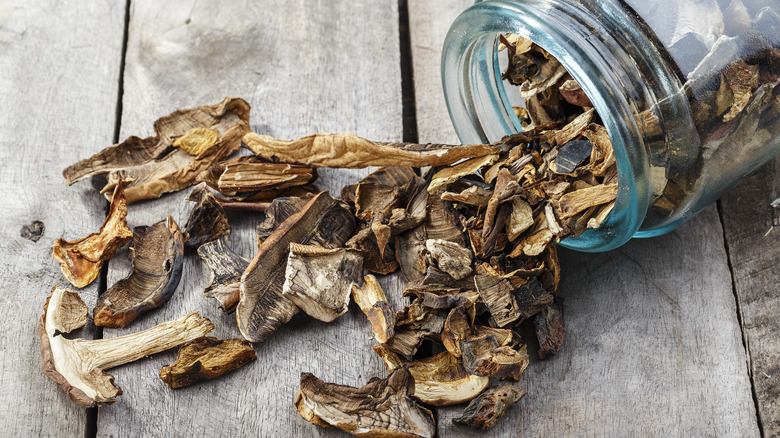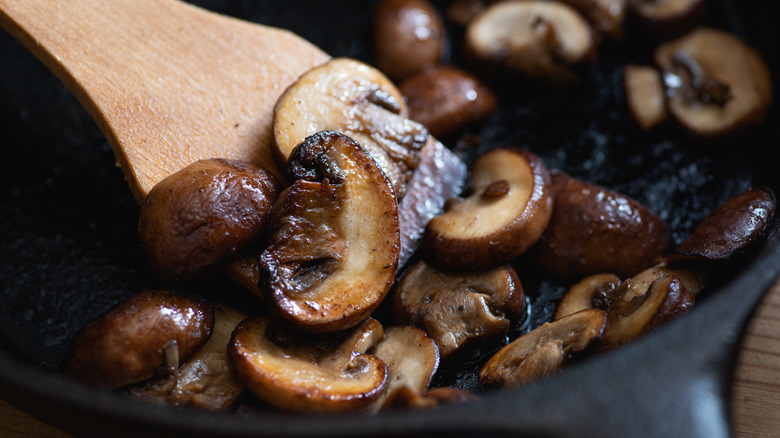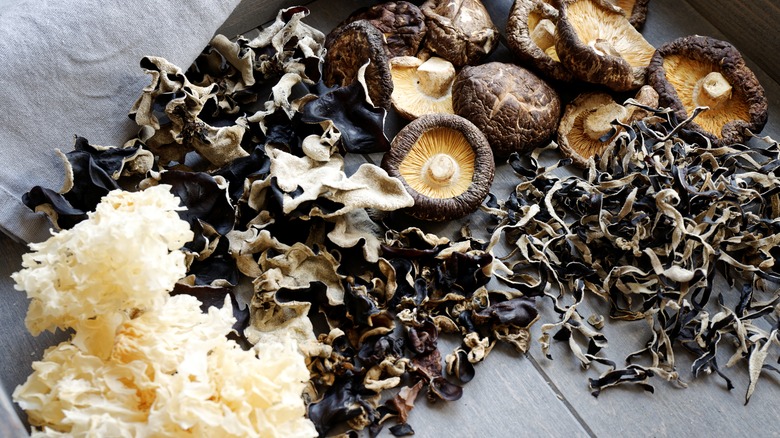Is It Possible To Rehydrate Dried Mushrooms?
As a form of fungi, mushrooms are related to neither plants nor animals. In fact, they are just the sporing structure of a massive network of roots called mycelium, which draws nutrients from decomposing organisms (via Britannica). Because of their ecological role as a decomposer, mushrooms are a symbol of regeneration, as they dwell in the liminal space of decay and recycle death back into new life. Mushrooms are mystical and delicious, but because they are unlike most other foodstuffs, the full scope of their culinary versatility is obscured and its easy to make a mistake when cooking with mushrooms.
Many foodies ascribe to the belief that the best mushrooms must be the freshest. Fresh produce is good and all, but enlightened cooks keep a cache of dried mushrooms in their spice cabinet for good measure. As chef Katie Button told Food and Wine, dried mushrooms actually have a more heavily concentrated flavor and are a great way to add an earthy, meaty, umami flavor to stocks, braising liquids, and stews. Master Class mentions also that dried mushrooms have a much longer shelf life (up to three years) than their fresh counterpart, which can get slimy just a little after a week. We know now that dried mushrooms can be used to liven up a dish, but is it possible to breathe life (or at least texture) back into the gills of dried mushrooms?
Mushroom revival
Yes, you can totally rehydrate dried mushrooms! The New York Times explains, "when soaked, dried porcini and other kinds of boletus mushrooms yield an essence that has a deliciously intense earthiness," while at the same time reinvigorating the spongey succulence of the mushroom's texture. America's Test Kitchen, however, notes that rehydrated mushrooms might still be slightly chewier and have a subtly different taste from fresh mushrooms. They suggest the best way to rehydrate them is to submerge the mushrooms in a pot with water, bring the liquid to a boil, let simmer for 15 to 30 minutes (or until soft), then strain out the liquid and pat down the mushrooms before sauteing and incorporating them into the dish.
It's also important to note that some types of mushrooms tend to be easier to rehydrate while others never really bounce back to their original freshness. Shiitake, morels, black trumpet, and porcini mushrooms are able to rehydrate nearly to their fresh former glory, though fresh porcinis do have a certain incomparable buttery texture than just isn't the same after rehydrating. Oyster mushrooms and chanterelles, on the other hand, don't reanimate quite so well and remain leathery or woody instead. But no need to throw out those dried chanterelles or oyster mushrooms, because they can still be ground up into a mushroom powder and utilized as a seasoning for rubs and spice blends.
Fresh or rehydrated: pros and cons
The mushroom's ability to revivify may have something to do with the way they retain nutrients even after being completely dehydrated. As noted by Far West Fungi, mushrooms are 80 percent water, so when dehydrated, one pound of fresh mushrooms can turn into just one ounce of dried mushrooms. But unlike other vegetables, mushrooms hold on to nearly all of their nutrition and flavor, so when they're reconstituted, it's as if the moisture and flavor never left.
Mushrooms are a fantastically dynamic ingredient that can enhance the heartiness and savory-ness of any dish it's featured. Fresh mushrooms have their advantages when it comes to texture and precise flavor, but they take up storage space (being mostly water), spoil easily, and can be hard to come by depending on harvest seasons. Dried mushrooms are a cost saving, less spacious, and longevity-efficient alternative to fresh mushrooms. They offer more concentrated flavor in less volume, they have a long shelf life, they can be available year-round, and once rehydrated, most varieties of fresh and dried mushrooms are practically interchangeable. Just be sure to properly store dried mushrooms in an airtight container out of direct sunlight (preferably in the freezer, according to Forest Mushrooms) and they'll stay good for years to come.


